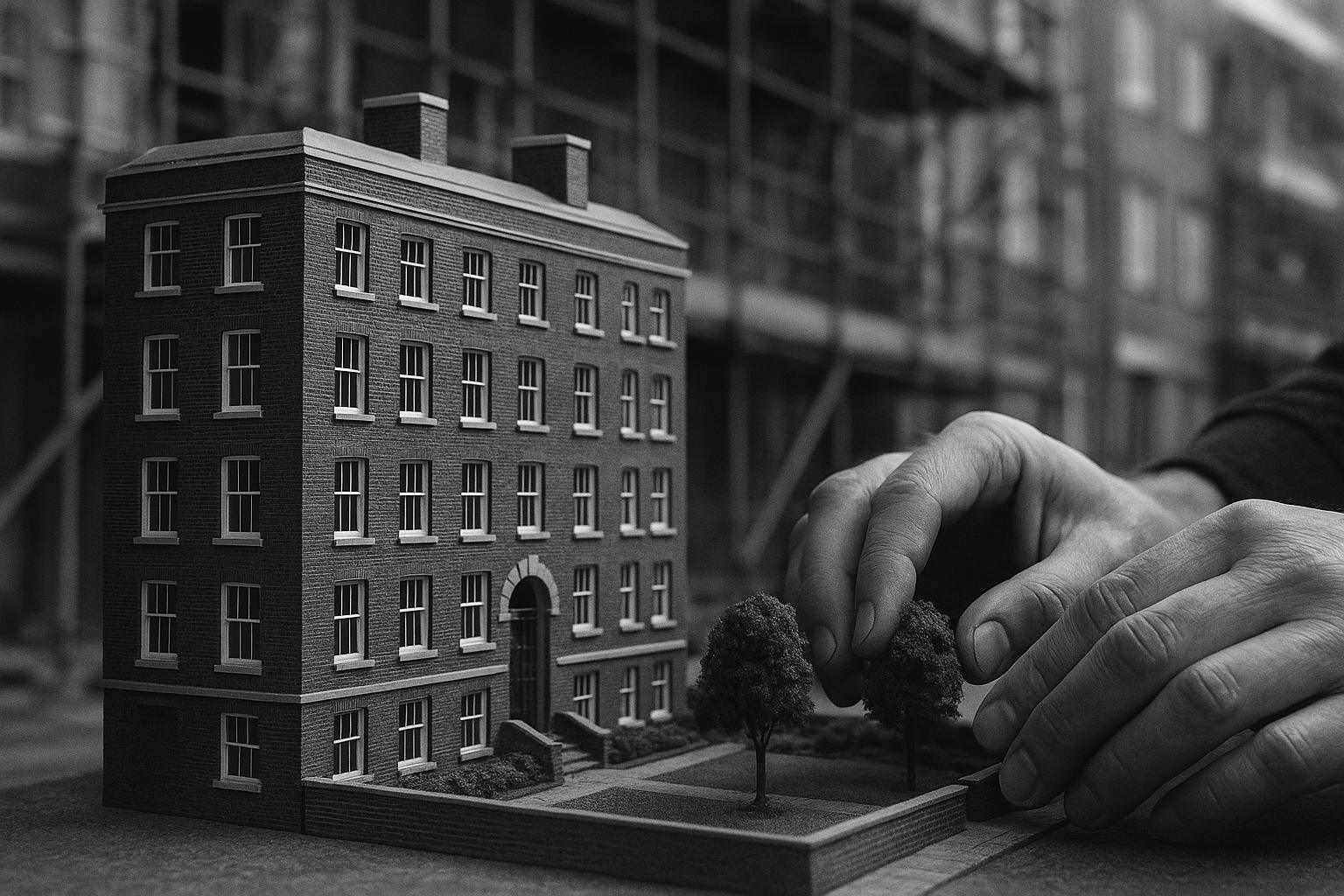Planning permission has been granted for Meadow Residential’s controversial Pentavia Retail Park masterplan, delivering 844 homes with 41% affordable housing in a perimeter‑led mansion‑block layout after a protracted call‑in, major redesign and tightened GLA carbon rules.
The controversial redevelopment of the long‑vacant Pentavia Retail Park in Mill Hill has been granted planning permission, unlocking a masterplanned scheme of 844 new homes centred on a reinterpretation of the London mansion‑block. According to the original report, the revised proposals provide 41% affordable housing and an articulation of interlocking blocks around landscaped communal courtyards — a dense, perimeter‑led layout the developer says will deliver a “green heart” for the neighbourhood. The scheme is being pursued by Meadow Residential with AFK Studios as lead designer. (Building Design; AFK Studios)
The approval follows a protracted planning tussle. Barnet Council originally refused an earlier incarnation of the scheme, which in 2017 proposed 724 homes with a lower affordable housing offer; the Mayor of London subsequently called the application in and, after a Mayoral hearing, approved the enlarged scheme on 25 July 2019. The Mayor signalled his decision as part of a wider push to use his intervention powers to “boost genuinely affordable housing”, noting the site’s potential to contribute to London’s housing supply. (London Mayor’s office; Estates Gazette; PropertyWire)
Designers present the scheme as a careful revival of a familiar London type. AFK Studios describes the masterplan as an updated mansion‑block typology — an articulated perimeter of blocks, interlocking massing and a network of private and shared courtyards — accompanied by extensive planting, rooftop amenity and terraces, all intended to improve wellbeing and create sheltered outdoor spaces for residents. The practice has said the project targets a WELL Community accreditation, an ambition that underlines the health and amenity rationale behind the communal landscape strategy. (AFK Studios)
Sustainability and carbon reduction were a key part of the rework that secured consent. Consultancy ChapmanBDSP, engaged on energy strategy, reports that tougher Greater London Authority carbon‑factor rules introduced in January 2019 forced a redesign of the scheme’s energy approach; the firm says the revised strategy will deliver at least a 50% reduction in on‑site carbon emissions, with further domestic emissions managed through offsets and an estimated annual saving in the order of 170 tonnes. The engineering team also highlight measures to mitigate noise and air‑quality impacts around the busy site. (ChapmanBDSP)
Planning advisers involved in the application point to intensive negotiation with GLA officers during the call‑in process. Quod, which handled the planning submission and strategy, records that the scheme was revised in response to council concerns about scale and massing and that the final consent permits heights ranging from four to sixteen storeys, reflecting a stepped approach to the perimeter blocks. The enlarged density was framed as a trade‑off to increase affordable provision and deliver a viable build‑to‑rent product. (Quod; Building Design)
The decision did not close local debate. Press accounts at the time recorded strong feelings locally about loss of the retail site’s previous uses and the impact of a large build‑to‑rent scheme on Mill Hill’s character. Meadow Residential and design partners argued the proposals would convert an unused retail park into a sustainable residential community and provide much‑needed homes for local workers, while critics warned about height, scale and the effects of intensification. The Mayor’s office noted the affordable proportion could rise further should grant funding become available. (Estates Gazette; PropertyWire; London Mayor’s office)
With planning permission in place the project moves into delivery planning and contractor procurement. Meadow Residential has set out the scheme as largely build‑to‑rent, with professional teams retained for design and engineering; industry observers say delivery will depend on market conditions and funding packages that can support the social and London Living Rent tenures promised in the consent. The complex path from retail park to mansion‑block neighbourhood underlines how mayoral powers, tougher environmental requirements and design ambitions are now shaping large‑scale housing proposals across London. (Quod; AFK Studios; ChapmanBDSP; London Mayor’s office)
Reference Map:
- Paragraph 1 – [1], [3]
- Paragraph 2 – [2], [6], [7]
- Paragraph 3 – [3]
- Paragraph 4 – [5]
- Paragraph 5 – [4], [1]
- Paragraph 6 – [6], [7], [2]
- Paragraph 7 – [4], [3], [5]
Source: Noah Wire Services
- https://www.bdonline.co.uk/news/go-ahead-for-metropolitan-workshops-affordable-mill-hill-mansion-blocks/5137599.article – Please view link – unable to able to access data
- https://www.london.gov.uk/press-releases/mayoral/mayor-approves-more-than-800-new-homes-in-barnet – On 25 July 2019 the Mayor of London approved the redevelopment of the disused Pentavia Retail Park in Mill Hill, granting planning permission for 844 new homes with 41% designated as affordable. The decision followed Barnet Council’s earlier refusal and the Mayor’s ‘call-in’ for further scrutiny. The revised scheme increased housing from 724 to 844 units and raised affordable provision from 35% to 41%, including social rent and London Living Rent tenures. The press release highlights the Mayor’s intention to use his powers to boost genuinely affordable housing and notes potential for affordable provision to rise with grant funding support.
- https://www.afkstudios.com/projects/mill-hill-pentavia/ – AFK Studios describes Mill Hill Pentavia as a transformative masterplan for the former Pentavia Retail Park delivering 844 homes, with 41% affordable housing and mixed tenures including build-to-rent. The scheme reinterprets the London mansion-block typology, creating an articulated perimeter of interlocking blocks around landscaped central courtyards and a ‘green heart’. AFK highlights sustainability and wellbeing ambitions — targeting the UK’s first WELL Community accreditation — with noise‑absorbing façades, extensive planting, over 10,000m2 of terraces and rooftop amenity, and measures to tackle air quality and noise. The client is Meadow Residential and the project status is planning granted design and delivery.
- https://www.quod.com/projects/pentavia-mill-hill/ – Quod’s project page records that Meadow Residential instructed the firm to submit and negotiate planning for Pentavia retail park, originally proposing over 700 homes. Quod explains Barnet Council’s objections to scale and the decision to engage the Mayor of London, who ‘called in’ the application. Following revisions negotiated with GLA officers the scheme was increased to 844 units with heights ranging from four to sixteen storeys and was presented at the 2019 Mayoral Hearing. Quod highlights their role in strategy and negotiation leading to the Mayor granting planning permission on the revised scheme and delivery support through construction phases partners.
- https://www.chapmanbdsp.com/news/mill-hill-project-passes-tough-new-gla-carbon-emission-regulations/ – ChapmanBDSP describes its engineering role on the Mill Hill Pentavia project, noting the Mayor of London granted planning permission after Barnet Council originally refused. The consultancy explains how new GLA carbon-factor regulations introduced in January 2019 required rework of the energy strategy to achieve tougher on-site carbon reductions. ChapmanBDSP reports the revised scheme will achieve at least a 50% reduction in on-site carbon emissions, with domestic assets secured via offsets, and identifies 170 tonnes annual savings. The piece highlights the scheme’s 844 homes, 41% affordable provision, landscaping and sustainability measures, and collaboration with AFK and Meadow Residential engineering and advisory.
- https://www.estatesgazette.co.uk/news/khan-approves-pentavia-retail-park-btr-scheme/ – Estates Gazette reported on 25 July 2019 that Sadiq Khan approved the revised Pentavia Retail Park proposals for 844 build-to-rent homes in Mill Hill and increased affordable housing to 41%. The article notes Meadow Residential’s earlier 2017 submission for 724 homes with 35% affordable provision and Barnet Council’s July 2018 refusal. Estates Gazette quotes the Mayor’s rationale that the site could make an important contribution to housing supply and records Meadow Residential’s comments about the need for quality, affordable homes for local workers. The piece summarises local controversy and the Mayor’s intervention that led to approval and national planning debate.
- https://www.propertywire.com/news/uk/london-mayor-over-rules-council-and-grants-permission-for-new-homes-on-disused-site/ – PropertyWire reported on 29 July 2019 that the Mayor of London called in and approved the Pentavia Retail Park redevelopment in Mill Hill after Barnet Council had refused the original plans. The revised proposal increased units from 724 to 844 and boosted affordable housing to 41%, including social rent and London Living Rent tenures. The piece quotes the Mayor on using his powers to increase genuinely affordable homes and includes Meadow Residential and AFK remarks about creating a sheltered ‘green heart’, planting hundreds of trees and converting the unused retail site into a sustainable residential community to benefit local workers.
Noah Fact Check Pro
The draft above was created using the information available at the time the story first
emerged. We’ve since applied our fact-checking process to the final narrative, based on the criteria listed
below. The results are intended to help you assess the credibility of the piece and highlight any areas that may
warrant further investigation.
Freshness check
Score:
8
Notes:
The narrative reports on the approval of a redevelopment project at Pentavia Retail Park in Mill Hill, London, which has been previously covered in 2019. The most recent development is the granting of planning permission for 844 new homes, with 41% designated as affordable housing. This approval follows a protracted planning process, including a refusal by Barnet Council in 2018 and subsequent intervention by the Mayor of London in 2019. The project’s design aims to reinterpret the London mansion-block typology, incorporating interlocking blocks around landscaped communal courtyards. The approval of this scheme is a significant development in the ongoing efforts to revitalise the site and address housing needs in the area. ([london.gov.uk](https://www.london.gov.uk/press-releases/mayoral/mayor-approves-more-than-800-new-homes-in-barnet?utm_source=openai))
Quotes check
Score:
7
Notes:
The narrative includes direct quotes from various stakeholders involved in the project, such as the Mayor of London, Sadiq Khan, and representatives from Meadow Residential and AFK Studios. These quotes have been previously reported in 2019, indicating that they are not new. The repetition of these quotes suggests that the content may be recycled from earlier reports. ([london.gov.uk](https://www.london.gov.uk/press-releases/mayoral/mayor-approves-more-than-800-new-homes-in-barnet?utm_source=openai))
Source reliability
Score:
9
Notes:
The narrative originates from Building Design, a reputable UK-based architecture and construction publication. The information is corroborated by official statements from the Mayor of London and other involved parties, lending credibility to the report. ([london.gov.uk](https://www.london.gov.uk/press-releases/mayoral/mayor-approves-more-than-800-new-homes-in-barnet?utm_source=openai))
Plausability check
Score:
8
Notes:
The claims made in the narrative align with previously reported developments regarding the Pentavia Retail Park project. The approval of 844 new homes with 41% affordable housing is consistent with earlier reports from 2019. The project’s design, aiming to reinterpret the London mansion-block typology, is plausible and reflects current architectural trends. ([london.gov.uk](https://www.london.gov.uk/press-releases/mayoral/mayor-approves-more-than-800-new-homes-in-barnet?utm_source=openai))
Overall assessment
Verdict (FAIL, OPEN, PASS): OPEN
Confidence (LOW, MEDIUM, HIGH): MEDIUM
Summary:
The narrative reports on the approval of a redevelopment project at Pentavia Retail Park in Mill Hill, London, which has been previously covered in 2019. The content includes recycled quotes from earlier reports, indicating a lack of new information. While the source is reputable and the claims are plausible, the recycling of content and quotes suggests that the narrative may not provide fresh insights into the project.













